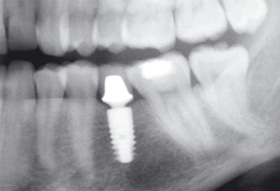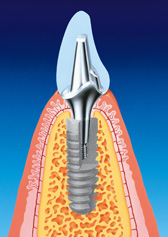Periodontology

Treatment of periodontal-related diseases, commonly known as periodontitis, as well as diseases of the oral mucosa.
The progression of periodontitis depends on the composition of the bacterial flora in the oral cavity and the thoroughness of the hygiene procedures performed by the patient.
Smoking is a very important pathogenic factor. The most important measure to prevent the progression of periodontitis is prophylaxis.
It consists of hygienic measures in the oral cavity performed by the patient at home and periodical professional removal of dental deposits (tartar and plaque) in the dental surgery.
Scaling can be performed by a dentist or a trained hygienist. If, however, there is damage to the tissues surrounding the tooth, it is the role of the periodontist to catch the inflammatory process at the earliest possible stage, reduce the damaging factors as effectively as possible and gradually restore the lost tissues.
We offer you a full range of periodontological treatments:
from extraction of supragingival and subgingival calculus, sandblasting and varnishing of teeth, through splinting (to achieve mutual stabilisation) to surgical procedures to clean and regenerate bone defects using Emdogain, Fisiograft, BIO-oss, Easygraft, own bone and various bio-membrane systems.
AIR FLOW PERIO therapy
It is the ideal solution for gingival and subgingival prophylaxis for complex prosthetic work and implants. Precise treatment with a specialised sand, based on glycine or erythritol, effectively removes biofilm from pockets 4 mm to 10 mm deep, both around natural teeth and implants. Regular prophylaxis with Air Flow therapy ensures permanent reduction in bacteria preventing tooth loss (periodontitis) or implant loss (periimplantitis).

In order to assess the condition of the bone and its predisposition for the placement of implants, a PANTOMOGRAPHIC PHOTOGRAPHY should be taken and a consultation with the implantologist should be carried out. As a result, it may be necessary to have a CT scan of the jaws as an additional diagnostic test or other general tests ordered by the implantologist.
We would also like to present you one of the latest developments in implantology. This is the NobelGuide method for the very precise planning of implant treatment, developed and introduced to authorised practices by Nobel Biocare.
It allows the implants to be immediately loaded with the final prosthetic work, which has already been carried out before the implantation. The procedure is carried out with minimal trauma to the tissues and the healing period is incomparably shorter than in traditional methods.
The planning of the procedure is carried out on the basis of a CT scan of the jaws and a radiographic template made specifically for this purpose.
The tomographic images are then analysed by the doctor in a computer programme. Implant phantoms are placed in the spatial image of the bone, precisely matched to its shape and size. On this basis, a surgical template is generated, allowing the planned solutions to be transferred to the patient’s mouth during surgery.
WHAT DOES THIS PROCEDURE LOOK LIKE FROM THE PATIENT'S SIDE?

After treating any caries and periodontal disease (oral decontamination), we make radiopaque templates (or use the patient’s old removable dentures) and a CT scan. The doctor then analyses the results obtained, makes a design for the restoration, orders the necessary components for the treatment and prosthetic work in the dental laboratory.
At this stage, there are no more impressions, fitting, adjustments etc. An appointment is made with the patient for the procedure, after which he or she leaves with a complete final or provisional (depending on the arrangements) prosthetic work. Slight pain and tissue swelling subsides within a few days. There is no need to remove sutures, as we do not incise the gums, we only remove a small section of them directly above the implant.
This entire procedure allows any restoration to be carried out on implants. As with other implant procedures, the condition is that the jawbone is in good condition and the patient is in good general health.

